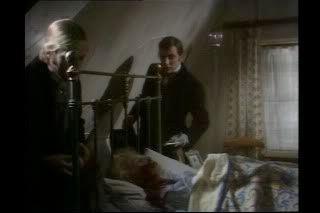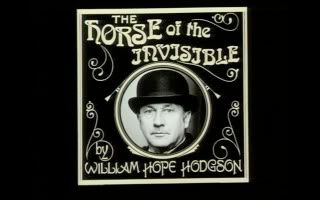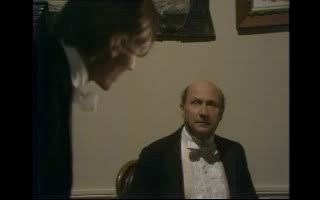

|
 |
Rivals of Sherlock Holmes (The) (TV)
R2 - United Kingdom - Network Review written by and copyright: Paul Lewis (17th June 2009). |
|
The Show
 
Sherlock Holmes is arguably the most iconic figure within the genre of crime fiction. The formula for Sir Arthur Conan Doyle’s short stories and novels featuring Holmes was imitated by numerous other Victorian authors, who modelled their creations on the eccentric and always objective ratiocinator. Produced for Thames Television in 1971, the anthology series The Rivals of Sherlock Holmes has its roots in the Penguin-published collections of short stories entitled The Rivals of Sherlock Holmes, which began in 1970 and was the first in a line of collections of Victorian- and Edwardian-era Holmes-inspired tales (including More Rivals of Sherlock Holmes in 1971 and The Further Rivals of Sherlock Holmes in 1973); all of these volumes were compiled and edited by Hugh Greene, the BBC broadcaster and brother of author Graham Greene. 
Taking their cue from the genre conventions established in Conan Doyle’s stories about the world’s most famous ‘consulting detective’ (the first of which, ‘A Study in Scarlet’, was published in 1887), the episodes in this anthology series represent adaptations of short stories by a number of Conan Doyle’s contemporaries. Stories adapted here include: R. Austin Freeman’s short story ‘A Message From the Deep Sea’ (from the 1909 collection John Thorndyke’s Cases), featuring Freeman’s character Dr John Thorndyke; ‘The Assyrian Rejuvenator’, written by Freeman under the pseudonym of Clifford Ashdown, from The Adventures of Romney Pringle (1902); ‘The Missing Witness Sensation’, by Ernest Bramah and featuring Bramah’s blind detective Max Carrados (this story is sourced from Bramah’s 1927 Max Carrados Mysteries); Arthur Morrison’s 1897 short stories ‘The Affair of the “Avalanche Bicycle and Tyre, Co., Ltd”’ and ‘The Case of the “Mirror of Portugal”’, both featuring the amateur sleuth Horace Dorrington and originally published in The Dorrington Deed Box; two of Arthur Morrison’s stories featuring Martin Hewitt, ‘The Case of Laker, Absconded’ (from The Chronicles of Martin Hewitt, 1895) and ‘The Affair of the Tortoise’ (from the 1894 collection Martin Hewitt, Investigator); ‘The Duchess of Wiltshire’s Diamonds’, from the 1897 short story by Guy Newell Boothby – featuring the gentleman thief Simon Carne, who masquerades as the detective Klimo (the story was collected in the 1900 volume A Prince of Swindlers); the 1910 short story ‘The Horse of the Invisible’ by William Hope Hodgson, featuring Hodgson’s ‘ghost detective’ Thomas Carnacki; Baroness Orczy’s ‘The Woman in the Big Hat’ (from Lady Molly of Scotland Yard, 1910); and ‘The Ripening Rubies’, by Max Pemberton (published in Jewel Mysteries I Have Known, 1894). The majority of these stories first appeared in publications such as Pearson’s Magazine (1896-1939), The Strand Magazine (1891-1950) and The Windsor Magazine (1895-1939). 
Each episode begins with a series of hand-coloured tin type-style images presented in such a way as to simulate the effect of a slide show, accompanied by narration which asserts that ‘In late Victorian London lived many detectives who were The Rivals of Sherlock Holmes’. Although clearly studio-bound, the series for the most part represents Victorian London as enshrouded in smog and threatened by outbursts of brutal violence: the first story, ‘A Message From the Deep Sea’, depicts Dr John Thorndyke’s (John Neville) investigation into the murder of a young woman who has been viciously stabbed in the throat. The representation of Victorian London as a place of Gothic nightmares was popular in the 1960s, 1970s and 1980s, as evidenced through a number of Hammer’s horror films (including Roy Ward Baker’s Dr Jekyll and Sister Hyde and Peter Sasdy’s Hands of the Ripper, both from 1971, and Terrence Fisher’s Frankenstein Must Be Destroyed, 1969), Jesús Franco’s 1976 film Der Dirnenmörder von London (Jack the Ripper) and Alan Moore and Eddie Campbell’s comic book series From Hell (1991-6). As early as 1971, the conventions of this particular subgenre of Victoriana were parodied in ‘The Phantom Raspberry Blower of Old London Town’, an episode within Ronnie Barker’s anthology series Six Dates With Barker (LWT, 1971); ‘The Phantom Raspberry Blower of Old London Town’ was later reworked and serialised within the 1976 series of The Two Ronnies (BBC, 1971-87).  
A distrust of the Victorian ‘bobbies’ is evident throughout these stories, largely sourced from the Victorian authors’ largely class-based prejudice against the bobbies. In these stories, the bobbies are usually depicted as methodical but stubborn and often wrong-headed. In ‘A Message From the Deep Sea’, Dr John Thorndyke refers to a policeman, Detective Sergeant Bates (Terence Rigby), as ‘the usual bluffer. Totally at a loss unless he catches his man red-handed or he’s told who did it by an army of informers’. As in Conan Doyle’s Sherlock Holmes stories, the amateur sleuth (or ‘consulting detective’) has, in comparison with the police, superior powers of reasoning and deduction. These amateur sleuths (and, notably, the authors of the stories in which they appear) are also of a ‘superior’ social class to the policemen: the bobbies, such as the aforementioned Detective Sergeant Bates, are invariably presented as semi-educated characters who speak in a coarse working-class London accent and dialect. Not all of the stories are based around simple cases of murder and theft. ‘The Horse of the Invisible’ features Donald Pleasance as Carnacki, the ‘ghost detective’ created in the stories by William Hope Hodgson. Carnacki is approached by Captain Hisgins (Tony Steedman). Hisgins’ daughter Mary (Michelle Dotrice) is engaged to marry Charles Beaumont (Michael Johnson). However, the Hisgins family suffers from a curse: as Hisgins tells Carnicki, ‘when the first-born girl’ in the Hisgins family ‘grew up and announced her engagement’, the presence of an ‘invisible horse’ makes itself known to the inhabitants of Hisgins Hall. The appearance of the invisible horse always presages the death of the family’s eldest daughter. Accepting Hisgins’ invitation and the challenge offered by the case, Carnicki decides to try to help the family rid themselves of the curse of the invisible horse, with the aim of saving the life of Mary. 
As this synopsis of ‘The Horse of the Invisible’ might indicate, William Hope Hodgson’s ‘ghost detective’ Carnacki is often seen as a precursor to Dennis Wheatley’s character of the Duc De Richelieu, and this adaptation of ‘The Horse of the Invisible’ recalls Terence Fisher’s 1968 film adaptation of Wheatley’s 1935 novel The Devil Rides Out, complete with Carnacki’s use of a ‘protective pentangle’ in his attempts to save the life of Mary. Disc One: 1. "A Message From the Deep Sea by R. Austin Freeman" (49:55) 2. "The Missing Witness Sensation by Ernest Bramah" (53:05) 3. "The Affair of the Avalanche Bicycle and Tyre Co. LTD. by Arthur Morrison" (53:02) Disc Two: 4. "The Duchess of Wiltshire's Diamonds by Guy Boothby" (51:28) 5. "The Horse of the Invisible by William Hope Hodgeson" (52:45) 6. "The Case of the Mirror of Portugal by Arthur Morrison" (51:16) Disc Three: 7. "Madame Sara by L. T. Meade & Robert Eustace" (53:02) 8. "The Case of the Dixon Torpedo by Arthur Morrison" (50:56) 9. "The Woman in the Big Hat by Baroness Orczy" (52:34) Disc Four: 10. "The Affair of the Tortoise by Arthur Morrison" (47:39) 11. "The Assyrian Rejuvenator by Clifford Ashdown" (51:32) 12. "The Ripening Rubies by Max Pemberton" (50:19) 13. "The Case of Laker, Absconded by Arthur Morrison" (48:31)
Video
Shot on videotape in a studio environment, the episodes in this series are well-represented in this DVD set from Network. There is evidence of the usual deficiencies associated with VT-recorded material, but on the whole these episodes look surprisingly good – much better than the recordings that have previously circulated amongst fans. 
Audio
The episodes are presented with a functional two-channel mono audio track; this is efficient and dialogue is always clear. However, there are no subtitles.
Extras
A single image gallery on disc one running 8:22.
Overall
A fantastic series collection a variety of very different stories of crime from the Victorian and Edwardian eras, The Rivals of Sherlock Holmes gets a hugely welcome release from Network. Sadly neglected, this is an excellent series, with much to offer to fans of crime-themed television, film and literature; there are some great performances here, from actors such as Peter Vaughan and Donald Sinden. The adaptations of the stories – mostly by Philip Mackie, Julian Bond and Bill Craig – are also very strong, never attempting to patronise the audience. Hopefully, Network will release the remaining episodes, and with luck Network will be able to secure some more in depth contextual material for any future releases of episodes from this series. For more information, please visit the homepage of Network DVD.
|
|||||

|